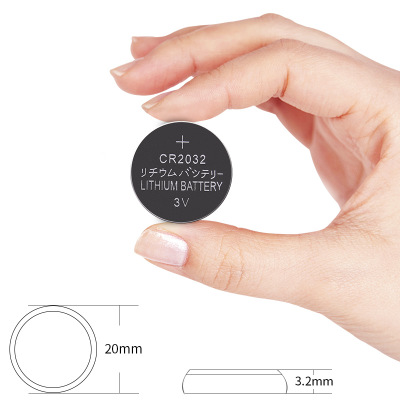Lithium CR2032 Battery 230mAh 3V
CR2032 Battery 3V 230mAh
Features:
- Shelf Life: CR2032 batteries generally have a long shelf life, often up to 10 years, when stored properly.
- Variations: While the CR2032 designation is standardized, slight variations in capacity and performance can occur between manufacturers.
- Safety: Like all batteries, CR2032 batteries should be handled and disposed of properly. They should be kept away from children due to their small size.
General Characteristics:
- Type: Lithium Coin Cell (Primary, non-rechargeable)
- Chemical System: Lithium / Manganese Dioxide (Li/MnO2)
Electrical Specifications:
- Nominal Voltage: 3.0 Volts
- Typical Capacity: 230mAh (milliampere-hours).
- Cut-off Voltage: Typically 2.0 Volts
- Continuous Drain: 0.2mA
- Operating Temperature: -30°C~60°C
- Self Discharge Rate: ≤3% (Stored for 12 months at room temperature)
Physical Specifications:
- Diameter: 20 mm
- Height: 3.2 mm
- Typical Weight: Approximately 3.0 grams
Performance and Operational Information:
- Self-Discharge: Very low, typically around 1% per year at room temperature, contributing to a long shelf life.
- Applications:
- Computer motherboards (CMOS batteries)
- Car key fobs
- Watches
- Calculators
- Medical devices
- Remote controls
- And many other small electronic devices
Performance and Test Methods
Test condition: Temperature 20℃~25℃; Humidity 65±20%.
| Item | Standard | Test Methods |
| Capacity | ≥ 1000h | Continuously discharge for 8 hours with load 15kΩ, till 2.0V end-voltage (for fresh battery only: within 3 months ) |
| Vibration test | Characteristics keep stability | Put battery on the platform of the vibrations machine, start the machine and adjust the frequency form 10 times per minute to 15 times per minute. keep it running for an hour |
| Leakage at high temperature | Leakage rate≤0.6% | Stored under temperature (45℃) for 30 days |
| Over discharge Test | No leakage allowed | After 2.0V end-voltage, continuously discharged for 5 hours |
Caution:
Use Nickel-plated iron or Nickel-plated stainless steel for the terminals that contact the battery.
Make sure that terminal contact pressure is 50g minimum, for a stable contact.
Keep the battery and contact terminal surfaces clean and free from moisture and foreign matter.
Before inserting the battery, check the battery contact terminals to make sure they are normal, not bent or damaged. (Bent terminals may not make good contact with the battery or may cause short circuit.)
When the batteries are piled up in a disorderly way, their positive and negative terminals may short-circuit, consuming some batteries while charging others, causing explosion.
Lithium batteries that are almost exhausted can output a voltage that is almost the same as that of a new battery:
Please does not judge a battery only with a Voltmeter. Do not mix batteries of different types and brands, or new and used batteries. We are well informed that battery pack should be assembled with single batteries of similar voltage, capacity and inner resistance.
Lithium batteries need a period of time to recover their normal voltage after even a slight short circuit. Therefore, if the battery is short-circuited, wait an adequate long time for batteries to recover before measuring their electrical characteristics.
Use a high impedance (1M or higher) voltmeter to measure battery voltage.
Add fuse between negative and connector. Once short circuit, it will cut immediately and permanently.
Do not contact terminals with conductive i.e. metal, goods. Keep batteries in non-conductive, i.e. plastic, trays.
Reduce impact to insulation layer from vibration, but the dimension will enlarge.
Battery characteristics vary with type and grade, even when batteries are the same size and shape. When replacing batteries with new ones, be sure to carefully check the symbols and numbers on them.
Related Battery
Contact Us for CR2032 3V 230mAh battery wholesale quotes






